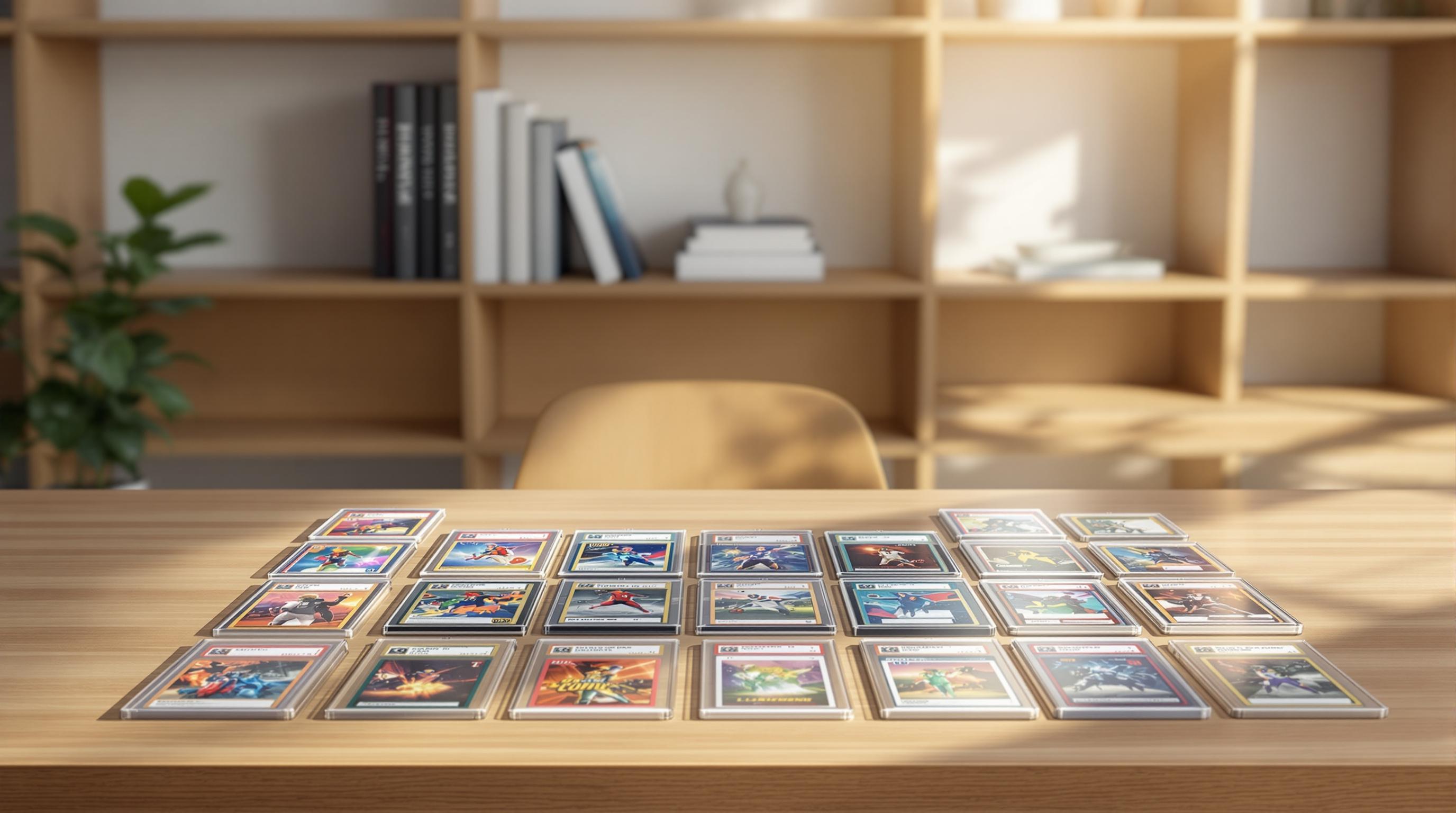Want to find rare trading cards? Here’s how you can identify low print runs quickly:
- Check Manufacturer Details: Look for serial numbers (e.g., "1/250"), special markings, or blockchain verification.
- Study Card Design: Unique features like foil treatments, parallels, or authentication elements often signal rarity.
- Analyze Codes and Markings: Production codes, serial numbers, and security features confirm authenticity and scarcity.
- Look for Production Errors: Mistakes like misprints or intentional limited editions can indicate smaller print runs.
- Monitor Market Trends: Rare cards sell quickly, maintain high prices, and show strong auction demand.
Metazoo 1st Edition Print Run Numbers - How Many of Each Holo Were Made

1. Look for Manufacturer Details
Understanding manufacturer details is key for collectors, especially as new techniques are used to indicate rarity. One of the clearest signals is serial numbering, which became common in the mid-1990s. For example, a card labeled "1/250" means it’s part of a 250-card print run [1].
Manufacturers highlight limited print runs in several ways:
- Serial Numbers and Print Run Patterns: Cards with serial numbers, especially those numbered to 25 or fewer, are highly sought after. This method gained traction in the 1990s [1].
- Special Markings and Variants: Examples include 'shadowless' Pokémon cards or the 1996 Select Certified Mirror Gold series, which featured distinct identifiers proving limited production [1][2].
- Production Identifiers: Manufacturer documentation can verify specific print runs, even for cards without serial numbers [2].
- Digital Verification: Blockchain technology and NFTs now allow collectors to confirm print runs instantly, offering a new level of transparency [1].
To make the most of this information, collectors should:
- Check official manufacturer announcements for print run details.
- Compare serial numbers across multiple copies to spot patterns.
- Verify markings and variants through reliable sources [1][3].
2. Study Card Design Features
Card design elements often hint at limited print runs, helping collectors identify rare items. These features are typically added by manufacturers to signal scarcity and attract collectors.
Unique Visual Details
Manufacturers frequently include special design touches to highlight limited-edition cards. For example, Magic: The Gathering 'Masterpieces' cards stand out with their exclusive foil treatments, making them easily distinguishable from standard prints [1].
Parallel Versions
Parallel cards add rarity by introducing elements like metallic finishes, altered numbering, or unique logos - without needing new imagery. A great example is the 1996 Select Certified Mirror Gold cards, which were capped at just 30 copies [2]. These variations retain the essence of the base card while incorporating features that signal their limited nature.
Security and Authentication Features
Modern cards often include advanced designs for both visual appeal and verification. Blockchain technology, for instance, is now used to ensure transparency by tracking print runs for both digital and physical cards through serialized data [1].
When evaluating rare cards, compare multiple copies, consult official checklists, and be cautious of counterfeits that mimic limited designs [1][4]. Pay close attention to consistent patterns and manufacturer-documented details to confirm authenticity.
While visual design elements are helpful, digging into codes and markings can provide even deeper insights into a card's rarity.
sbb-itb-0db97a5
3. Analyze Codes and Markings
Manufacturers use advanced systems to confirm the rarity and legitimacy of collectible cards. Knowing how to interpret these codes and markings helps collectors identify rare pieces and ensure their authenticity.
How Verification Works
Serial numbers and production identifiers are essential tools for confirming rarity. For example, a card marked "1/100" shows its place in a limited production run. Special versions, like "shadowless" Pokémon cards, highlight rarer editions [1]. This practice gained traction in the 1990s for premium cards.
The Shift in Authentication
Rarity indicators have come a long way - from simple set numbers before 1995 to today's blockchain-based systems. Blockchain technology now allows precise tracking of both physical and digital card production, offering transparency while maintaining exclusivity [1].
Why It Matters in the Market
Cards with verified low print runs often fetch higher prices. Manufacturers frequently produce cards with runs as small as 25 copies, showcasing a deliberate approach to creating scarcity [2].
To analyze codes and markings effectively, collectors should focus on these steps:
- Cross-Check Serial Numbers: Match serial numbers with official manufacturer databases.
- Study Patterns: Examine production codes across multiple cards for consistency.
- Spot Security Features: Learn to identify legitimate authentication elements.
While these codes and markings are reliable indicators of rarity, errors in production can sometimes lead to unexpected treasures - more on that in the next section.
4. Check for Production Errors
Production mistakes and intentional scarcity by manufacturers are important clues when identifying cards with limited availability.
Unintentional Errors: Mistakes like miscuts, misprinted text, or incorrect cardstock often point to smaller print runs since quality control usually removes these flawed cards during production [1].
Intentional Limited Editions: Sometimes, manufacturers purposely limit production to create exclusivity. A well-known example is the 1996 Select Certified Mirror Gold cards, with only 30 copies ever made [2].
How to Confirm Rarity: Collectors can confirm the rarity of a card by reviewing manufacturer documents. These provide official details about print quantities and variations.
Market Impact: While production errors or limited print runs can make a card rare, rarity alone doesn’t guarantee high value. Factors like popularity and demand play a big role. For instance, the 1993 Finest Refractor, with just 241 copies, became highly valuable due to both its limited availability and strong collector interest [2].
For those looking to add rare cards with production errors or limited runs to their collection, specialized card shops can help. These shops often provide expert authentication services and access to hard-to-find items, ensuring buyers get the real deal.
Understanding production quirks is just one part of the puzzle. Keeping an eye on market trends can help collectors better gauge how rarity influences a card’s value.
5. Monitor Market Trends
Market trends can highlight low print runs through observable patterns and key indicators. Rare cards often show up less frequently in the market, maintain high prices across different sellers, sell out quickly upon release, and perform well in auctions.
Key Indicators to Watch:
- Sales volume and how often items are sold
- Price trends over time
- Availability in the current market
- Auction results and bidding activity
Using online market tools makes tracking these factors easier by offering real-time data on sales and price changes. Manufacturers also provide useful details about print runs in product announcements, which can help collectors spot upcoming limited editions [1].
The concept of rarity has evolved, with modern cards sometimes limited to runs of just 25 or fewer [2]. A great example is the 1997 Flair Showcase, which introduced 1-of-1 cards, showing how manufacturers and market demand work together to shape card value [2].
The combination of true scarcity and strong collector interest has the biggest impact on a card's value. By pairing these market trends with the design elements and manufacturer details mentioned earlier, collectors can better spot and acquire rare cards.
Conclusion
The card market continues to evolve, with new technologies and scarcity strategies making it more challenging for collectors to identify rare cards. Thankfully, advanced tools and resources now make it easier to pinpoint those elusive low print runs.
"The rarity of a card is a major factor in its value. Collectors are willing to pay a premium for cards that are hard to find."
To successfully spot low print run cards, collectors should focus on:
- Researching manufacturer details and serial numbers
- Recognizing unique design features like "shadowless" variants
- Keeping a close eye on market trends
- Building connections with trustworthy dealers
Take, for example, the 2009-10 Sidney Crosby rookie card, which sold for $120,000. This highlights just how valuable rare and well-preserved cards can be.
For those looking for expert advice, Card Shops List offers a detailed directory of stores specializing in sports cards and TCGs. It’s a great resource for connecting with professionals who can help authenticate and evaluate rare cards.


